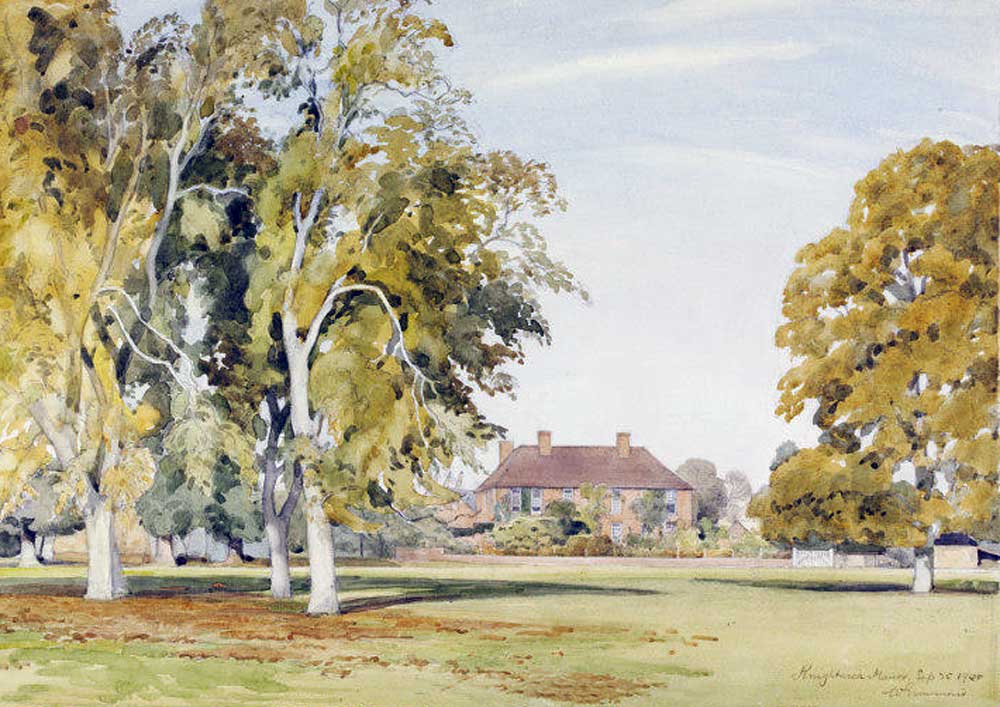 |
Grimmond, William, born 1884 - died 1952.
Knightwick Manor (Recording Britain, Worcestershire).Pencil and watercolour drawing on paper, 25th September 1940.
A view of Knightwick Manor Farm, here Grimmond looks like he is just sat inside the Manor grounds just off the Knightwick to Suckley road.
The Farm house is brick with hipped, tiled roof. 2 storeys and platt band; 7 bays, 2:3:2, with 4 brick pilasters, one at each end and at main bay divisions; windows are 18-pane sashes with gauged flat heads except for 2 end bays to right where upper left window is blocked and 2 ground floor windows which have a wooden mullion and 2 transomes; there is a small wooden sign with DAIRY painted on it above the right ground floor window; central half-glazed, panelled double doors recessed within moulded architrave and canopy with simple moulded detail. Brick stacks to ridge above pilasters to central 3 bays. Interior Hall fireplace has late carved oak panelled chimney-piece; Parlour has Jacobean panelling with fluted frieze with early aedicule in south wall with painting of 4 nude children at back of recess, plaster ceiling of four deep panels with moulded edges, and late carved oak chimneypiece; part of early dog-legged stair with a moulded handrail and turned balusters survives above first floor level. The farmhouse is built upon the sandstone cellars of a earlier building; three 2- light mullioned cellar windows survive in the south elevation.
This work is from the 'Recording Britain' collection of topographical watercolours and drawings made in the early 1940s during the Second World War. In 1940 the Committee for the Employment of Artists in Wartime, part of the Ministry of Labour and National Service, launched a scheme to employ artists to record the home front in Britain, funded by a grant from the Pilgrim Trust. It ran until 1943 and some of the country's finest watercolour painters, such as John Piper, Sir William Russell Flint and Rowland Hilder, were commissioned to make paintings and drawings of buildings, scenes, and places which captured a sense of national identity. Their subjects were typically English: market towns and villages, churches and country estates, rural landscapes and industries, rivers and wild places, monuments and ruins. Northern Ireland was not covered, only four Welsh counties were included, and a separate scheme ran in Scotland.The scheme was known as 'Recording the changing face of Britain' and was established by Sir Kenneth Clark, then the director of the National Gallery. It ran alongside the official War Artists' Scheme, which he also initiated. Clark was inspired by several motives: at the outbreak of war in 1939, there was a concern to document the British landscape in the face of the imminent threat of bomb damage, invasion, and loss caused by the operations of war. This was allied to an anxiety about changes to the landscape already underway, such as the rapid growth of cities, road building and housing developments, the decline of rural ways of life and industries, and new agricultural practices, which together contributed to the idea of a 'vanishing Britain'. Clark also wanted to help artists, and the traditional forms of British art such as watercolour painting, to survive during the uncertain conditions of wartime. He in turn was inspired by America's Federal Arts Project which was designed to give artists employment during the Great Depression of the 1930s.
Over 1500 works were eventually produced by 97 artists, of whom 63 were specially commissioned. At the time the collection had a propaganda role, intended to boost national morale by celebrating Britain's landscapes and heritage. Three exhibitions were held during the war at the National Gallery, and pictures from the collection were sent on touring exhibitions and to galleries all around the country. After the war, the whole collection was given to the V&A by the Pilgrim Trust in 1949, and it was documented in a four volume catalogue published between 1946 and 1949. For many years the majority of the collection was on loan to councils and record offices in each county, until recalled by the V&A around 1990. The pictures now form a memorial to the war effort, and a unique record of their time.
©peh

